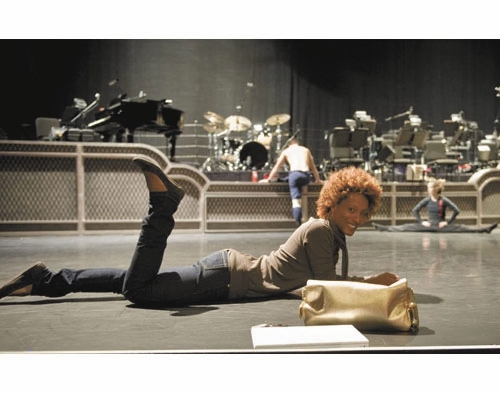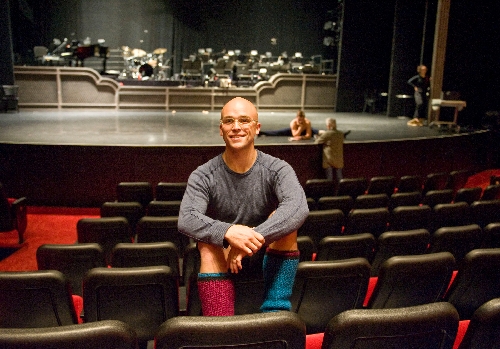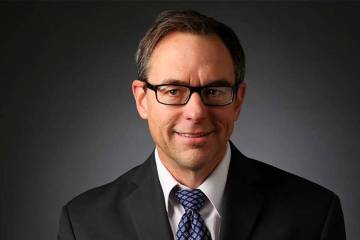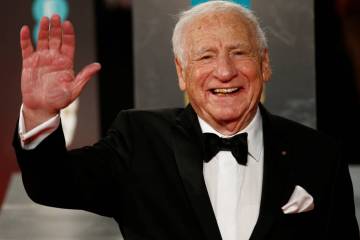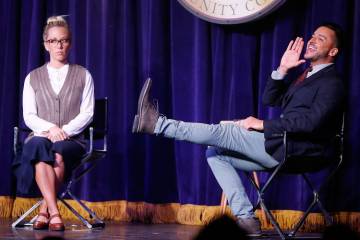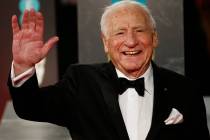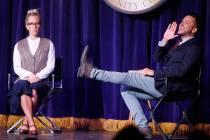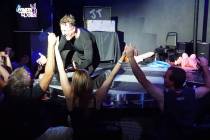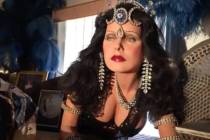Hard work, training at root of performances in ‘Sinatra Dance With Me’
They're on the edge of the desert and of a new dance frontier.
"The hell with the winter in New York, that's what I say," declares a gleeful Karine Plantadit, the African scene-stealer of "Sinatra Dance With Me," the Twyla Tharp tribute to the Vegas legend that has been extended at Wynn Las Vegas through April 2.
Beyond a taste of the sunny days Las Vegans call winter, the New York-based dancers are getting a dose of the Strip and even the pop culture foreground, given the "Dancing with the Stars" ballroom craze and "Black Swan's" bringing ballet drama to Sunday's Oscars.
"For a long time, in a music video, the dancers were the background and the person singing was the focus," says Charlie Neshyba-Hodges, whose pratfalls as a love-struck bartender are a mix of Gene Kelly and Jackie Chan. "What we're seeing happening a lot more -- and what's really exciting for us -- is the dancers are pushing forward into the front line."
Neshyba-Hodges and his movie-musical stage partner, Laura Mead, sat still with Plantadit for a few minutes to talk about the show and its challenges.
How do they do it?
It may be the most-asked question by those filing out of "Sinatra." Dance seems too simple a word for the acrobatics that fit perfectly alongside the neighboring "Le Reve" or Cirque du Soleil.
"We're throwing in windmills and break-dancing, acrobatics and tumbling. There's even a little soft shoe toward the end. It's all-encompassing. ... It's really a full-body experience," Neshyba Hodges says.
Sneak into the theater in the daytime, however, and your question will be answered by what looks more like a conventional ballet class.
When Tharp isn't running the cast through rehearsals for the actual show (which has grown by a song since it opened in December), dancers are putting together their own combinations to non-Sinatra music.
"We take these classes every day, we rehearse this for months, so that we can get onstage and think about whatever we need to think about in that moment," Mead says.
"When you do a show over and over, you really develop a muscle memory" for the specific moves of the show, Neshyba-Hodges says. "You need to have a backup system."
"I spend most of my day preparing my body for the night," Plantadit says. "The way I eat, everything I do, because it's our instrument. The effortlessness that we show, we're training for that."
"It comes with eight hours of preparation," Neshyba-Hodges adds.
"The effort is the invisible part. But I think art is that way," Plantadit notes. "The invisible part is a bit like that place where you actually mold and you actually become the material and you add inspiration or the research one does for a character. It's the invisible.
"They will never see that. But they will feel it."
Twyla people
Tharp has been synonymous with the front edge of modern dance since the early '70s. "Sinatra" continues a penchant for dancers who look more like characters in a movie than ballet dancers. For some of them, this is the third Broadway musical with her.
At 5-foot-5, Neshyba-Hodges credits the choreographer for rescuing him from "the expected norms for a male dancer. I'm supposed to be a couple inches taller, several pounds thinner, have more hair," he says.
"Twyla from the beginning was very open-minded. She prioritizes the talent and what they're supposed to bring, and not what they're supposed to look like."
"Twyla is one of those people who are truly wanting you to succeed. And I think you can feel this in an audition," says Plantadit, who in her career has found auditions to be a good barometer of what is to come. "If the audition process is funky, be prepared for funky all the way."
But auditioning with Tharp was more of a dialogue: "Not, 'What can you do?' But, 'What can we do together?'
"I feel that's the reason why our characters were able to evolve. ... She wants you to be part of the process."
What do you call this show?
"Sinatra" continues Tharp's themed Broadway tributes that began with her hit Billy Joel compendium "Movin' Out," and continued with the less successful Bob Dylan vehicle "The Times They Are A-Changin'."
The dancers play the same characters for the run of the show and stay onstage most of the time in period costumes.
You have to watch faces as well as feet, whether it's Neshyba-Hodges and Mead in the throes of young, Mickey-and-Judy romance or the grown-up, Frank-and-Ava stormy weather of Plantadit and stage partner Keith Roberts.
"It's a new genre, I feel," says Plantadit, who was raised in Cameroon before joining Alvin Ailey's dancers and later the Broadway company of "The Lion King."
"It's actually the evolution of dance, that's the way I feel about it," she adds. "We have been trained on the ballet barres, in the modern classes, in African classes, whatever we took, and we are able to tell a full story (of a character): their lows, their ups and downs, their inner secrets, their everything."
"That's one of the pleasures of this show," says Mead, who has been paired with Neshyba-Hodges for more than two years, for both the show's Atlanta debut and Broadway run.
"For all of us, we've trained so long, working smaller stages and trained in the concert dance world, to bring really, really high level of dance to the masses in this commercial venue is really satisfying. To not dumb anything down, but make it really accessible, really exciting."
"There's always a moment of what's going to be next? Where do we go from here?" Plantadit says. "But it's always going to be up to us."
For now, she says, the public can see that all dancing is not a competition.
And "young dancers who are coming up behind us" can know they may be asked "to grow more and more. You have to go take acting classes. You cannot stop right there at your ballet barre. ... You can do it all and become a full artist onstage. There is an actual venue for it.
Contact reporter Mike Weatherford at mweatherford@ reviewjournal.com or 702-383-0288.
Preview
"Sinatra Dance With Me"
7:30 p.m. Monday-Thursday
Encore Theater at Wynn Las Vegas, 3131 Las Vegas Blvd. South
$81.40-$103.40 (770-9966)



